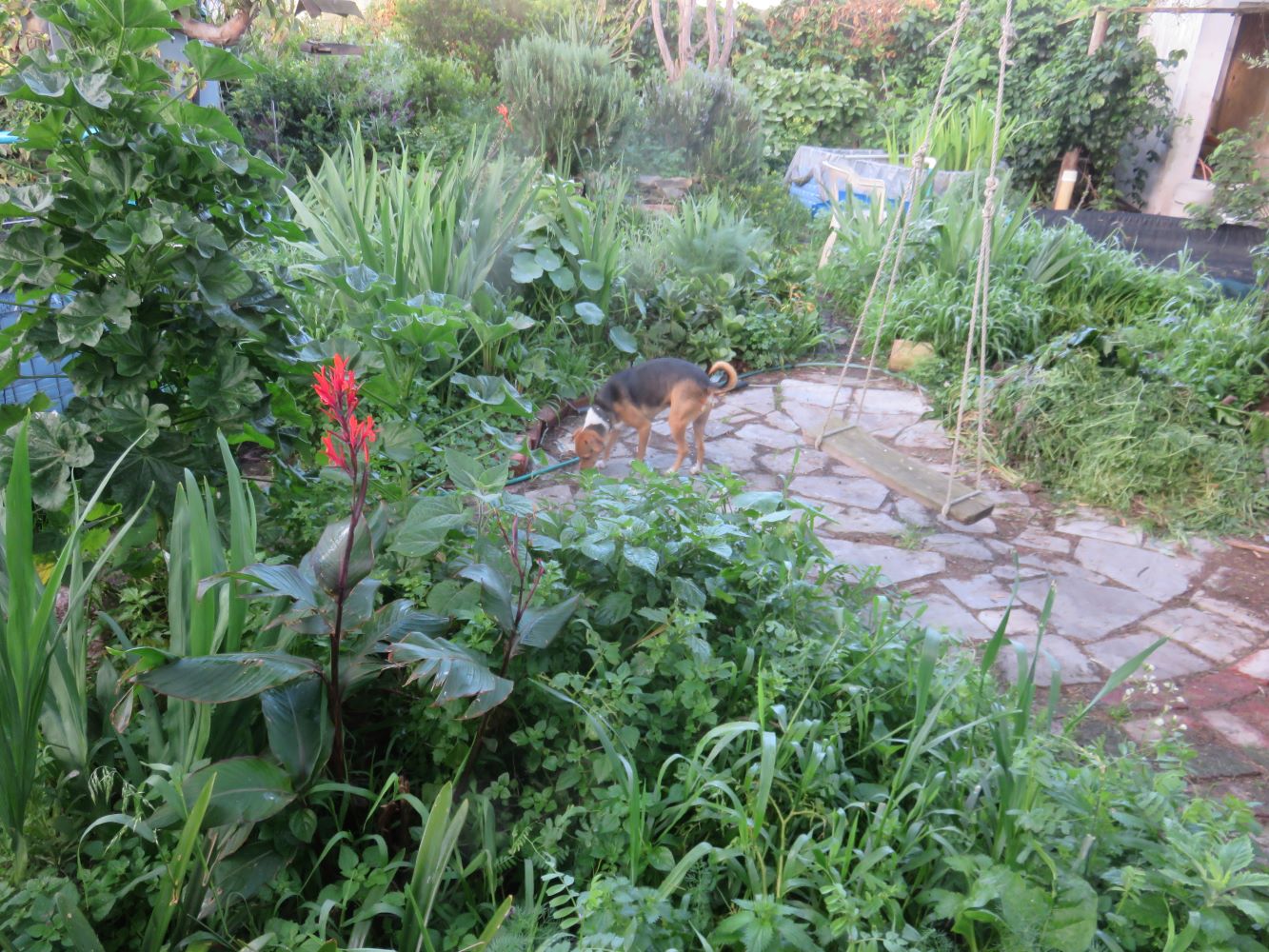Dear Reader, in this age of AI created content, please support with your goodwill someone who works harder to provide the human-made. Sign up in the righthand column or bottom of this page. You will receive my hand illustrated monthly newsletter RESTORE NATURE and access to the biodiversity garden design course as I write...and nothing else, I respect your time.
a permablitz in cape town
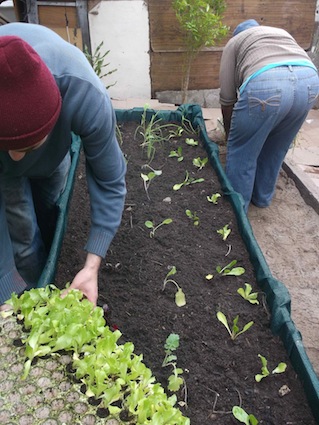
A Permablitz, a term used by SEED team permaculture designers, Imraan Samuels and Saudiq Jamodien, is a co-operative event in which large groups of volunteers convert outside spaces at people's homes into permaculture gardens with rain tanks, gray water systems and plantings of fruit trees and vegetables, in one or two days. This brilliant project idea is I hope only the start of many many more similar projects.
There has recently been a blitz of permablitzes in Mitchell's Plain, recorded by Imraan on facebook. I believe 12 blitzes in all. The last permablitz of this series was held on the 27th and 28th of August. At the home of Nadia, and her son Waleed. I also met a number of regular volunteers, such as Sandra, Ebrahim and Patricia, and the whole operation was managed by Imraan and Saudiq.
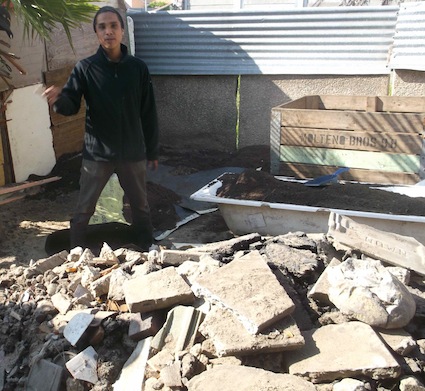
a before snapshot of the back yard. Imraan surveys the materials which can be used in the permablitz
In the back yard, which underwent the most spectacular transformation during the permablitz, materials discarded from commercial industrial processes were brought in and used, such as woodchips and sawdust, which costs R16 for a bag taller than two men, and upcycled palettes and agricultural containers made of wood,
Materials available onsite such as branches and weeds which were collected on the pavement outside, some tires whose treads were too worn down to be sellable, from Waleed’s tire business next door, and piles of rubble from the concrete surfacing which they had pulled up in the last week to make way for trees were all used. The tires were packed full of rubble and then rammed and piled up layer by layer to make a platform for the gray water tank and the rainwater tank so that gravity would help create downward pressure for the irrigation.
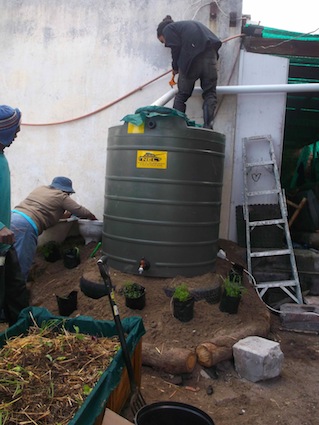
Imraan secures the input to the rain tank, after rerouting the gutters, while the base of tires and rubble is covered over and planted with groundcovers
The roof downpipe leads into the rainwater tank, with an irrigation hose and some drip irrigation too. The greywater exit from the house wall (kitchen sink and shower) leads into an old bath found onsite. This is filled with wood chip. Its exit, where the plug would be, was conducted with piping into a sink full of woodchips, topped by a tripod, and overflows into a swale. The swale irrigated the fruit trees we planted.
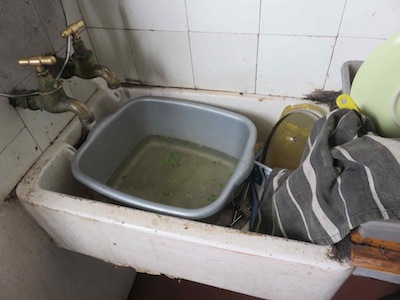
the gray water filter in place
The swale is built by digging a trench, lining it with cardboard and filling it with wood chips or sawdust to conduct the overflow down the garden, filtering it as it goes, absorbing excess nitrogen in the greywater, and preventing anoxic conditions. The trees were planted in a sequence with water and nitrogen lovers closest to the greywater outlet. If I remember correctly it was banana, and bamboo, and a giant indigenous swamp restio, closest to the grewater sink, then a fig, a macadamia nut tree, pomegranate and olive at the dryest sunniest point.
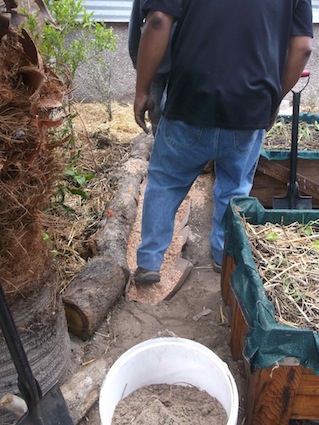
stamping and compacting the sawdust in the swale
The walls and fences were equipped with wooden slats attached to the wall and supporting wire trellises threaded taught between these for supporting grenadilla vines.
A team of women painted the large wooden planters with a mix of linseed and vinegar. We all helped carry out the remaining rubble in buckets.
Before planting the trees, the beds were delineated with logs from the city’s tree felling operations. The whole surface of the garden was blanketed in brown cardboard boxes, with the staples and plastic removed, and then the beds on the ground were covered with straw, and permaculture stalwarts like yarrow, strawberries, mint and so forth, were planted in cardboard lined holes, or with some compost. The whole was bombed with seeds, a mix of of cover crops like beans, linseed, coriander and sesame scattered around and then covered. The beds were mulched with straw and the paths with wood chips.
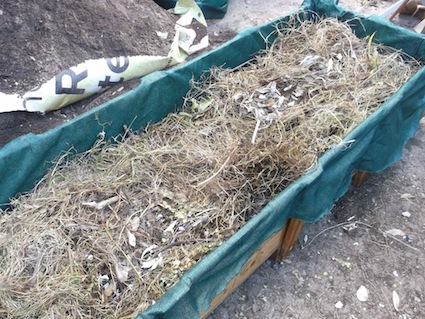
The 3 wooden planters made from pallets were placed to allow plenty of space to move around them, and taking the passage of the sun into consideration. Notably the trees were also planted against the south wall so that they do not rob the garden of sun. Then the wooden boxes were stuffed with organic garden waste from the area, with the finer material on the top, and this was topped with compost. Lettuces and onions were planted and then the soil was mulched with straw.
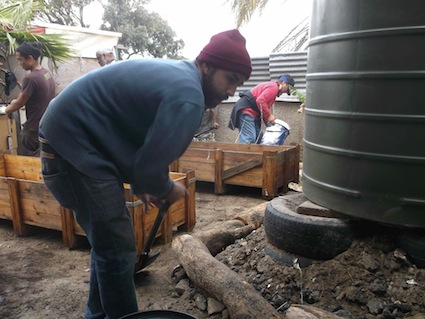
The stack of tires was banked up with garden soil, and
planted with tough soil stabilizing plants like lobster plant, or plectranthus, comfrey and the cover crop seed cocktail.
A worm bin was constructed for Nadia’s use, out of buckets, a
tap, gravel and shade net, to collect worm tea, one of the most incredible
plant foods, and everything, back and front, was sprinkled with a liquid
mixture containing charcoal and effective micro-organisms prepared by Saudiq. After this, on the next day, the permablitz team moved to the front garden.
------
home page links to a diversity of gardening ideas and inspiration
------
gardening links for useful information on saving resources even in decorative gardening
------
------
the article on the permablitz of the front garden, explaining how its done
an album of pictures on the permablitz
SEED, the organization behind the permablitz idea
invitation to contribute
You’re a home gardener ! Share your experiences and questions !
We all know about home gardening. Tell us about your successes, challenges and ask about issues that bother you. You may have the luxury of a back garden, but there are other ways we learn. Few people age without growing something or buying vegetables during their lives ! It is absolutely guaranteed that you have learned things which can help others on their gardening journey.
We invite you to share your stories, ask questions, because if a thing has bothered you it will bother others too. Someone may have a solution ! No question is too small. There is learning for everyone involved, for you, for me (yes, I learn from every question), for us all. Exciting stuff !
We are starting on a new journey. Every week we will profile your letters ! The best stories and questions we receive.
What Other Visitors Have Said
Click below to see contributions from other visitors to this page...
Permablitz team say thanks ! 




Thanks for the awesome post Caroline :). Much gratitude to you for detailing your experience with us - I'm sure the inspiration of the 2 days will now …
Restore Nature Newsletter
I've been writing for four years now and I would love to hear from you
Please let me know if you have any questions, comments or stories to share on gardening, permaculture, regenerative agriculture, food forests, natural gardening, do nothing gardening, observations about pests and diseases, foraging, dealing with and using weeds constructively, composting and going offgrid.
SEARCH
Order the Kindle E-book for the SPECIAL PRICE of only
Prices valid till 30.09.2023
Recent Articles
-
garden for life is a blog about saving the earth one garden at a time
Apr 18, 25 01:18 PM
The garden for life blog has short articles on gardening for biodiversity with native plants and regenerating soil for climate amelioration and nutritious food -
Cape Flats Sand Fynbos, Cape Town's most endangered native vegetation!
Apr 18, 25 10:36 AM
Cape Flats Sand Fynbos, a vegetation type found in the super diverse Cape Fynbos region is threatened by Cape Town's urban development and invasive alien plants -
Geography Research Task
Jan 31, 25 11:37 PM
To whom it may concern My name is Tanyaradzwa Madziwa and I am a matric student at Springfield Convent School. As part of our geography syllabus for this
"How to start a profitable worm business on a shoestring budget
Order a printed copy from "Amazon" at the SPECIAL PRICE of only
or a digital version from the "Kindle" store at the SPECIAL PRICE of only
Prices valid till 30.09.2023

